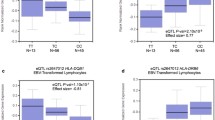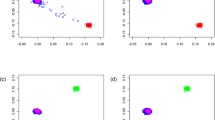Abstract
Patients treated successfully for pediatric Hodgkin’s lymphoma are known to develop secondary malignancies; care is already taken in treatment to prevent this adverse effect. Recent GWAS study identified rs4946728 and rs1040411 noncoding SNPs located between PRDM1 and ATG1 genes on chromosome 6q21 as risk factors for secondary malignancies in patients formerly treated with radiotherapy for pediatric Hodgkin disease. We investigated the allele frequencies of these two SNPs in biobanked, randomly selected DNA of average, apparently healthy Hungarians (n = 277) and in samples of Roma (n = 279) population living Hungary. The risk allele frequency for rs4946728 was 79.4 % in Hungarian and 83.5 % in Roma samples, while for rs1040411 it was 56.4 % in Hungarian and 55.8 % in Roma samples. These values are quite similar in the two populations, and are rather high. The values are higher than those frequencies observed in the controls (rs4946728: 59.1 % and rs1040411: 39.6 %, p < 0.05), and are in the range of the cases (86 % and 68.2 %, respectively) of the above original GWAS study. Our findings suggest, that beside the already taken precautions, genetic characterization of Hungarian pediatric Hodgkin patients seems to be advantageous prior to the treatment of their disease.
Similar content being viewed by others
References
Friedman DL, Whitton J, Leisenring W, Mertens AC, Hammond S, Stovall M, Donaldson SS, Meadows AT, Robison LL, Neglia JP (2010) Subsequent neoplasms in 5-year survivors of childhood cancer: the Childhood Cancer Survivor Study. J Natl Cancer Inst 102:1083–1095
Meadows AT, Friedman DL, Neglia JP, Mertens AC, Donaldson SS, Stovall M, Hammond S, Yasui Y, Inskip PD (2009) Second neoplasms in survivors of childhood cancer: findings from the Childhood Cancer Survivor Study cohort. J Clin Oncol 27:2356–2362
O’Brien MM, Donaldson SS, Balise RR, Whittemore AS, Link MP (2010) Second malignant neoplasms in survivors of pediatric Hodgkin’s lymphoma treated with low-dose radiation and chemotherapy. J Clin Oncol 28:1232–1239
Best T, Li D, Skol AD, Kirchhoff T, Jackson SA, Yasui Y, Bhatia S, Strong LC, Domchek SM, Nathanson KL, Olopade OI, Huang RS, Mack TM, Conti DV, Offit K, Cozen W, Robison LL, Onel K (2011) Variants at 6q21 implicate PRDM1 in the etiology of therapy-induced second malignancies after Hodgkin’s lymphoma. Nat Med 17:941–943
Keller AD, Maniatis T (1991) Identification and characterization of a novel repressor of beta-interferon gene expression. Genes Dev 5:868–879
Shaffer AL, Lin KI, Kuo TC, Yu X, Hurt EM, Rosenwald A, Giltnane JM, Yang L, Zhao H, Calame K, Staudt LM (2002) Blimp-1 orchestrates plasma cell differentiation by extinguishing the mature B cell gene expression program. Immunity 17:51–62
Shapiro-Shelef M, Calame K (2005) Regulation of plasma-cell development. Nature reviews. Immunology 5:230–242
Chang DH, Angelin-Duclos C, Calame K (2000) BLIMP-1: trigger for differentiation of myeloid lineage. Nat Immunol 1:169–176
Yan J, Jiang J, Lim CA, Wu Q, Ng HH, Chin KC (2007) BLIMP1 regulates cell growth through repression of p53 transcription. Proc Natl Acad Sci U S A 104:1841–1846
Lin FR, Kuo HK, Ying HY, Yang FH, Lin KI (2007) Induction of apoptosis in plasma cells by B lymphocyte-induced maturation protein-1 knockdown. Cancer Res 67:11914–11923
Nadasi E, Gyurus P, Czako M, Bene J, Kosztolanyi S, Fazekas S, Domosi P, Melegh B (2007) Comparison of mtDNA haplogroups in Hungarians with four other European populations: a small incidence of descents with Asian origin. Acta Biol Hung 58:245–256
Semino O, Passarino G, Quintana-Murci L, Liu A, Beres J, Czeizel A, Santachiara-Benerecetti AS (2000) MtDNA and Y chromosome polymorphisms in Hungary: inferences from the palaeolithic, neolithic and Uralic influences on the modern Hungarian gene pool. Eur J Hum Genet 8:339–346
Tomory G, Csanyi B, Bogacsi-Szabo E, Kalmar T, Czibula A, Csosz A, Priskin K, Mende B, Lango P, Downes CS, Rasko I (2007) Comparison of maternal lineage and biogeographic analyses of ancient and modern Hungarian populations. Am J Phys Anthropol 134:354–368
Sipeky C, Lakner L, Szabo M, Takacs I, Tamasi V, Polgar N, Falus A, Melegh B (2009) Interethnic differences of CYP2C9 alleles in healthy Hungarian and Roma population samples: relationship to worldwide allelic frequencies. Blood Cells Mol Dis 43:239–242
Sipeky C, Csongei V, Jaromi L, Safrany E, Polgar N, Lakner L, Szabo M, Takacs I, Melegh B (2009) Vitamin K epoxide reductase complex 1 (VKORC1) haplotypes in healthy Hungarian and Roma population samples. Pharmacogenomics 10:1025–1032
Kalaydjieva L, Gresham D, Calafell F (2001) Genetic studies of the Roma (Gypsies): a review. BMC Medical Genetics 2:5
Bombard Y, Abelson J, Simeonov D, Gauvin FP (2013) Citizens’ perspectives on personalized medicine: a qualitative public deliberation study. Eur J Hum Genet
Emmert-Streib F (2012) Personalized medicine: Has it started yet? A reconstruction of the early history. Front Genet 3:313
Grosse SD, Khoury MJ (2006) What is the clinical utility of genetic testing? Genetics in Med: Off J Am College of Med Genetics 8:448–450
Pasic MD, Samaan S, Yousef GM (2013) Genomic medicine: new frontiers and new challenges. Clin Chem 59:158–167
Marshall E (2011) Human genome 10th anniversary. Waiting for the revolution. Science 331:526–529
Behrens C, Travis LB, Wistuba II, Davis S, Maitra A, Clarke EA, Lynch CF, Glimelius B, Wiklund T, Tarone R, Gazdar AF (2000) Molecular changes in second primary lung and breast cancers after therapy for Hodgkin’s disease. Cancer Epidemiology. Biomarkers and Prevention 9:1027–1035
Constine LS, Tarbell N, Hudson MM, Schwartz C, Fisher SG, Muhs AG, Basu SK, Kun LE, Ng A, Mauch P, Sandhu A, Culakova E, Lyman G, Mendenhall N (2008) Subsequent malignancies in children treated for Hodgkin’s disease: associations with gender and radiation dose. Int J Radiat Oncol Biol Phys 72:24–33
Neglia JP, Friedman DL, Yasui Y, Mertens AC, Hammond S, Stovall M, Donaldson SS, Meadows AT, Robison LL (2001) Second malignant neoplasms in 5-year survivors of childhood cancer: childhood cancer survivor study. J Natl Cancer Inst 93:618–629
Robison LL, Green DM, Hudson M, Meadows AT, Mertens AC, Packer RJ, Sklar CA, Strong LC, Yasui Y, Zeltzer LK (2005) Long-term outcomes of adult survivors of childhood cancer. Cancer 104:2557–2564
Sipeky C, Csongei V, Jaromi L, Safrany E, Maasz A, Takacs I, Beres J, Fodor L, Szabo M, Melegh B (2011) Genetic variability and haplotype profile of MDR1 (ABCB1) in Roma and Hungarian population samples with a review of the literature. Drug Metababolism and Pharmacokinet 26:206–215
Acknowledgments
This work was supported by the grant of Hungarian Scientific Research Foundation, OTKA K 103983.
Author information
Authors and Affiliations
Corresponding author
Rights and permissions
About this article
Cite this article
Varszegi, D., Duga, B., Melegh, B.I. et al. Hodgkin Disease Therapy Induced Second Malignancy Susceptibility 6q21 Functional Variants in Roma and Hungarian Population Samples. Pathol. Oncol. Res. 20, 529–533 (2014). https://doi.org/10.1007/s12253-013-9724-z
Received:
Accepted:
Published:
Issue Date:
DOI: https://doi.org/10.1007/s12253-013-9724-z




